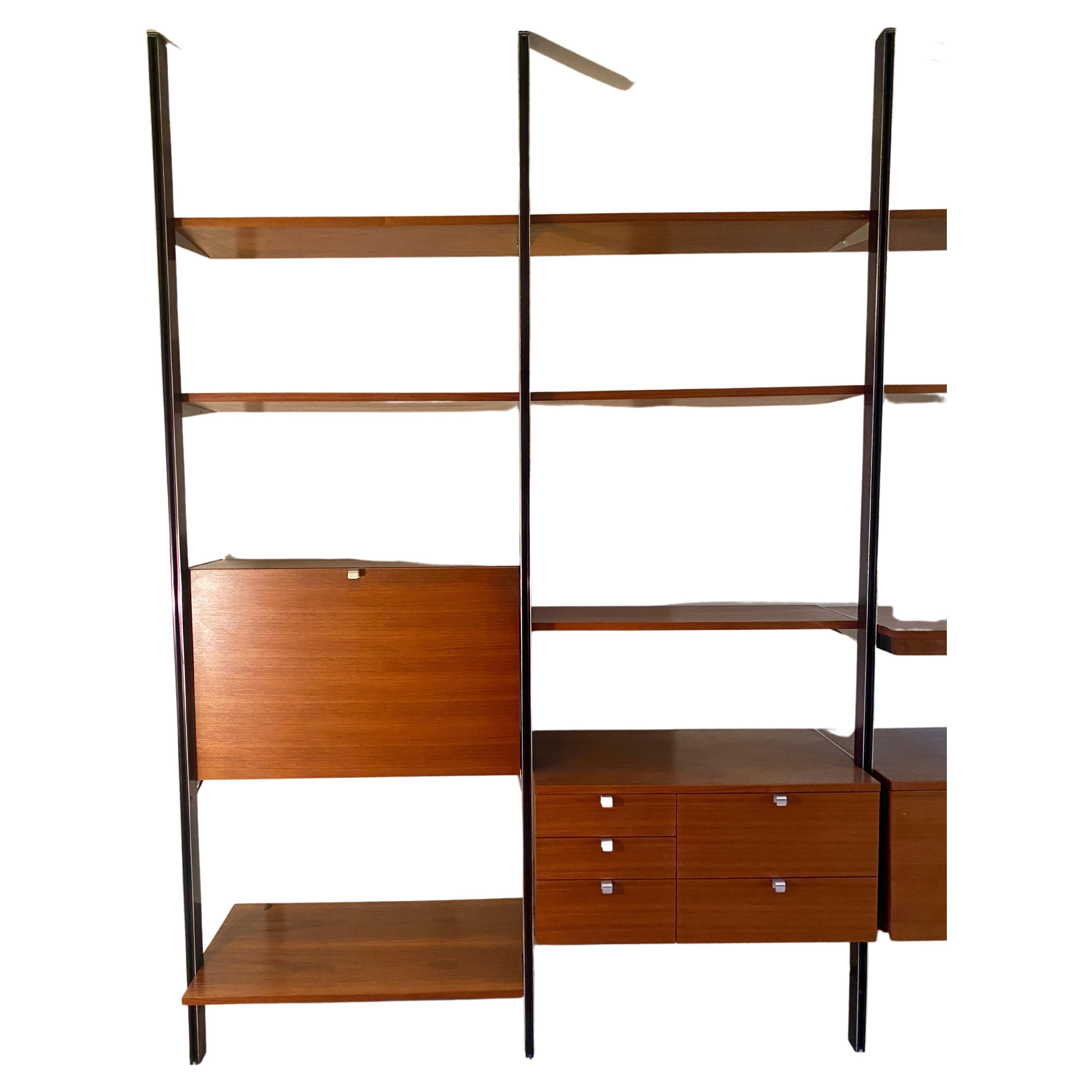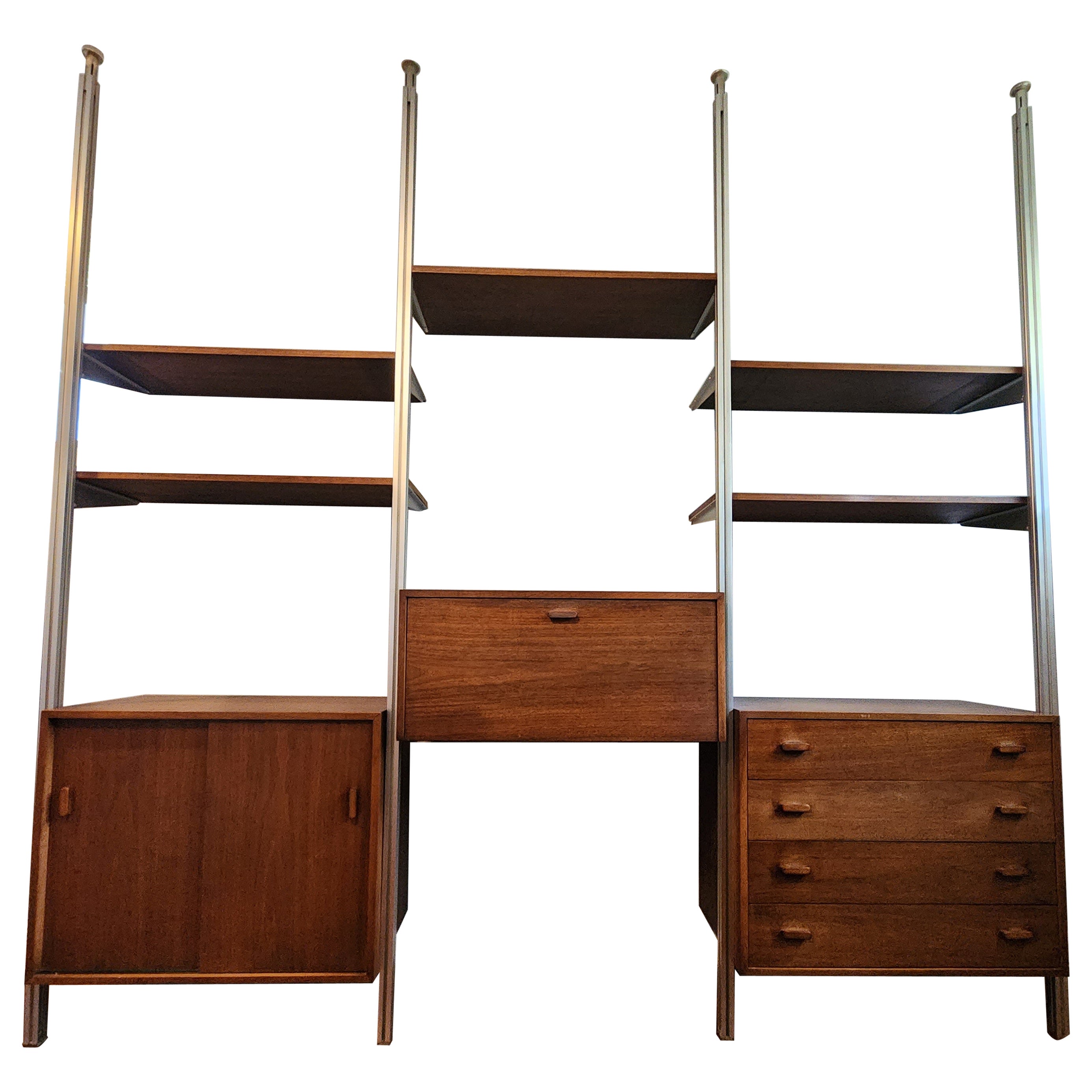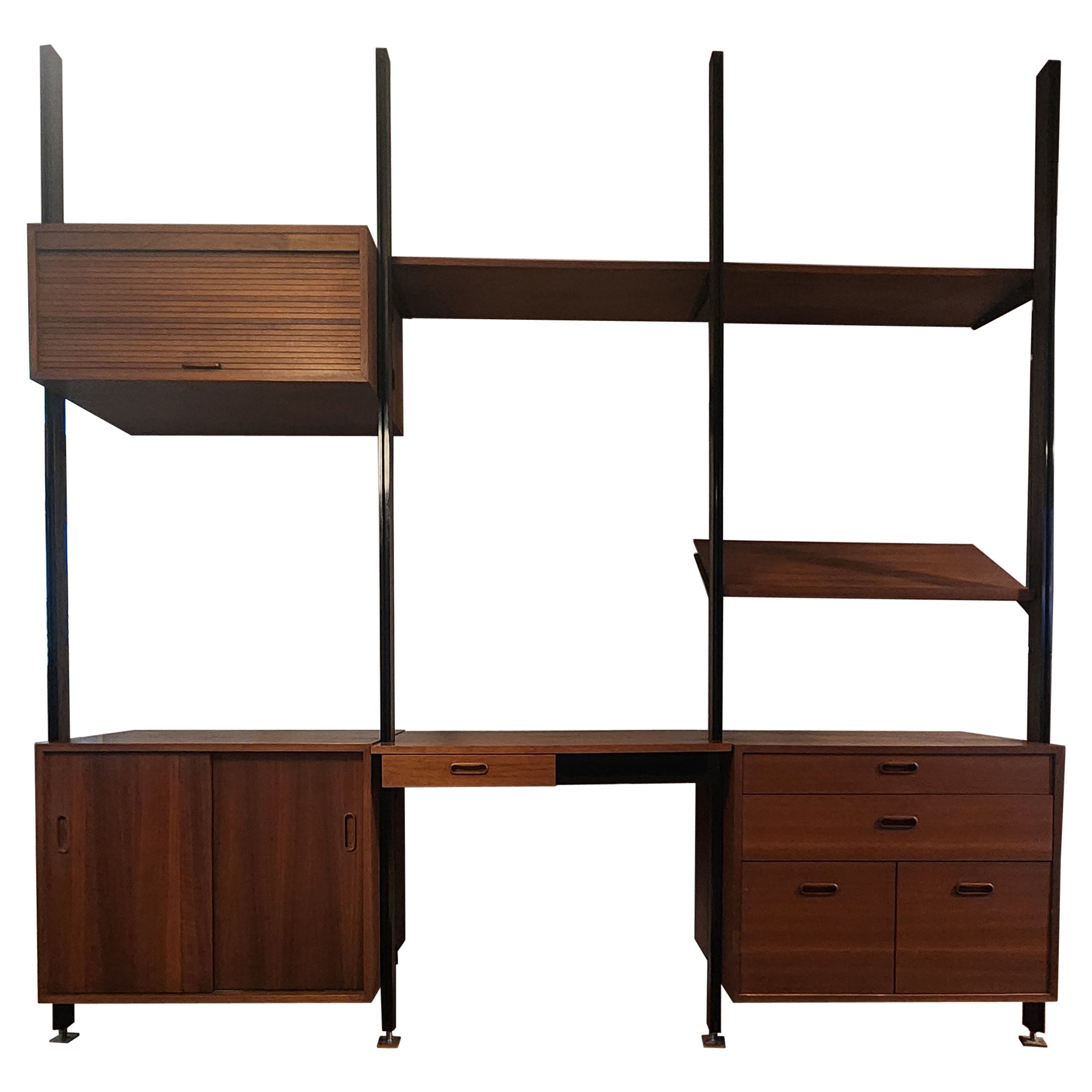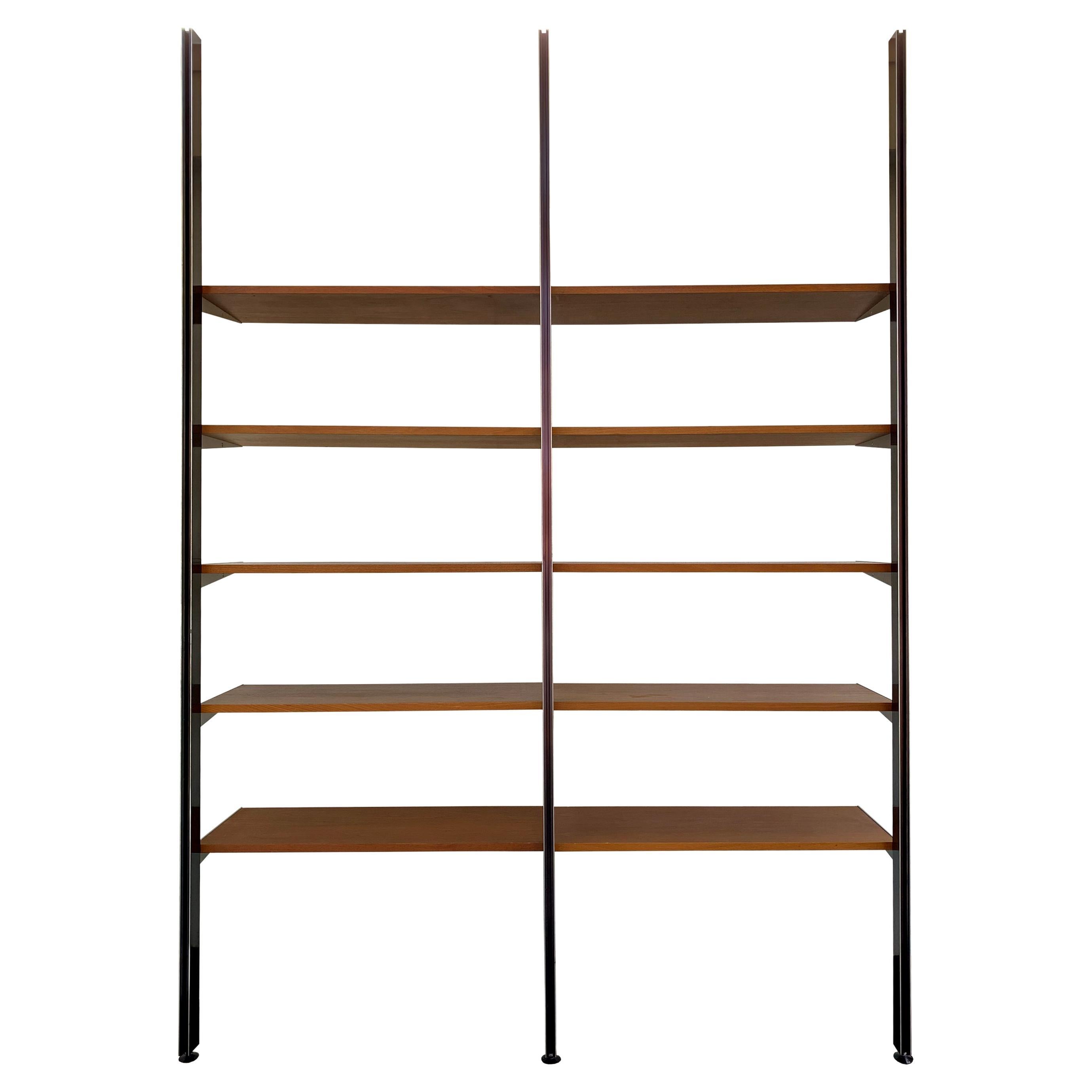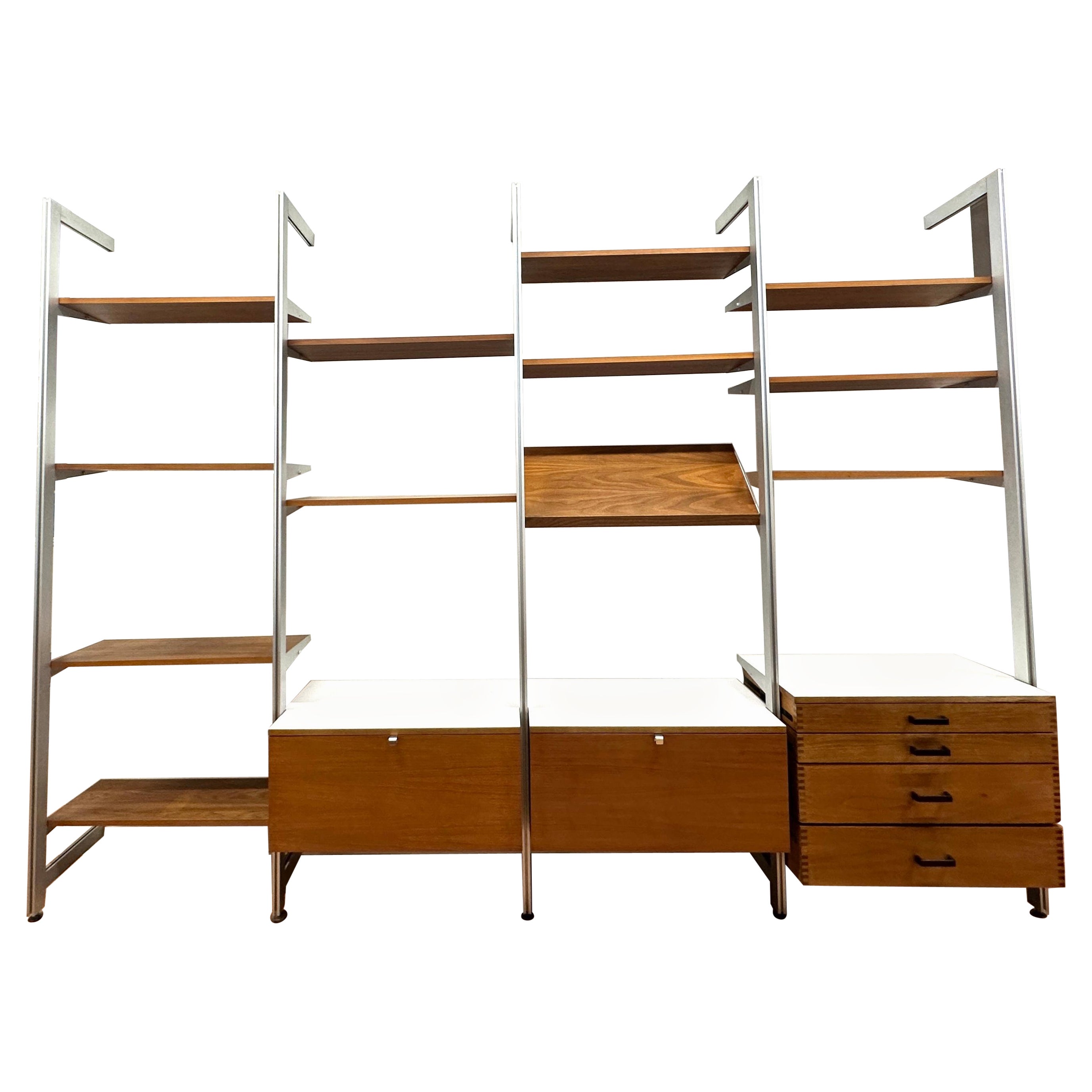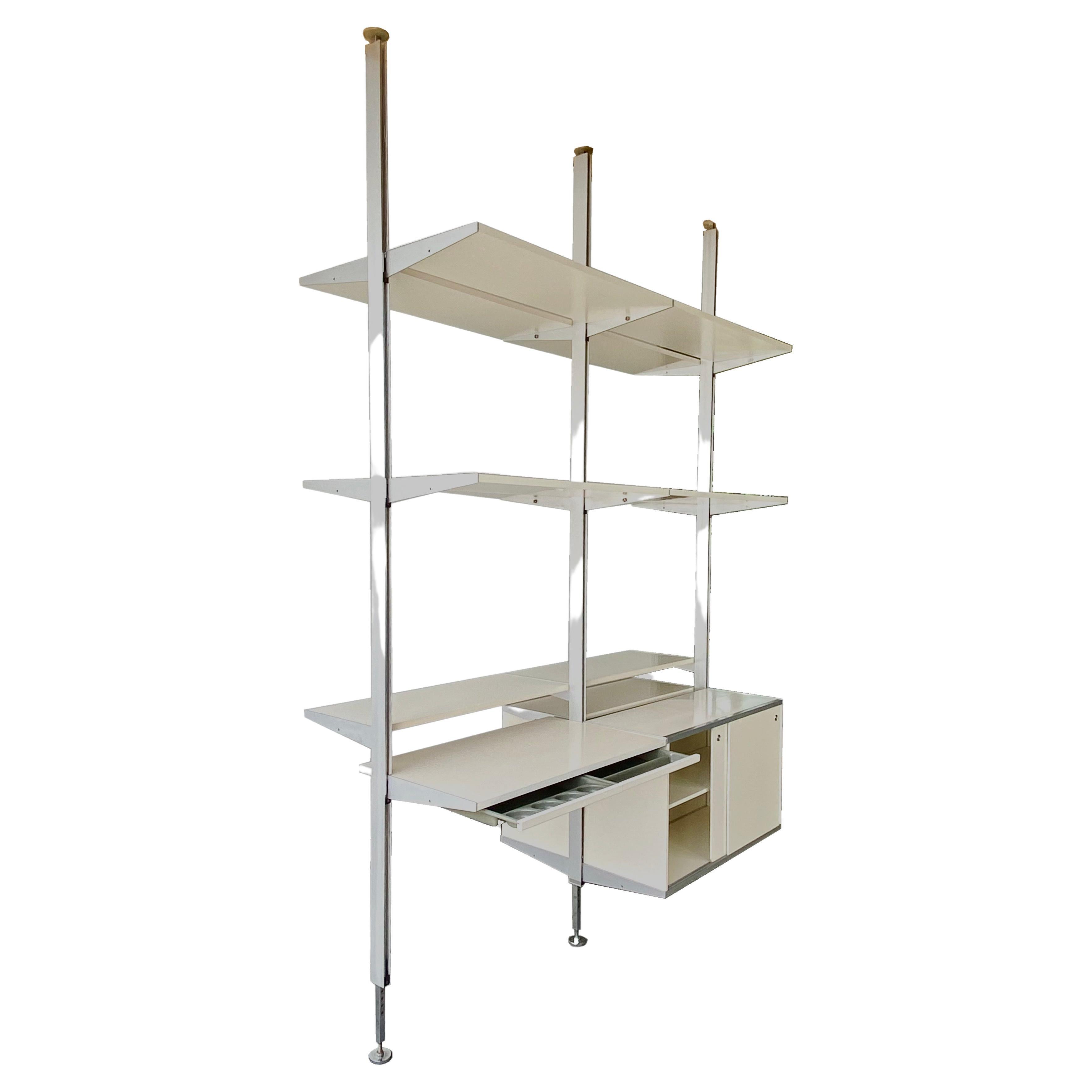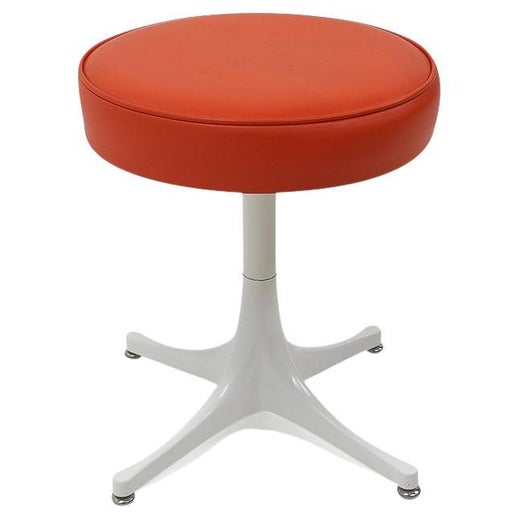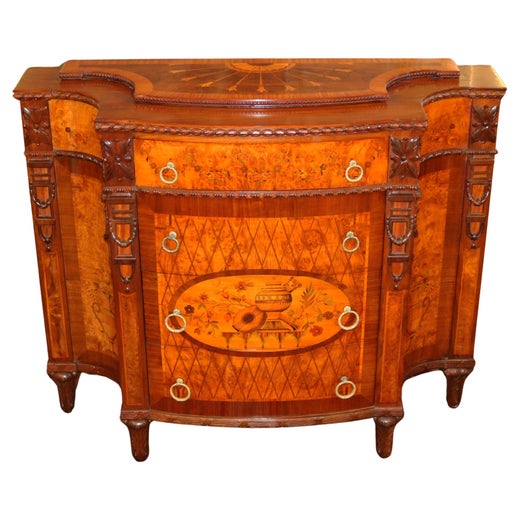George Nelson for Herman Miller 3 Bay Omni System Mid Century Shelving Wall Unit
About the Item
- Creator:Herman Miller (Manufacturer),George Nelson (Designer)
- Dimensions:Height: 90 in (228.6 cm)Width: 76.75 in (194.95 cm)Depth: 13.75 in (34.93 cm)
- Style:Mid-Century Modern (Of the Period)
- Materials and Techniques:
- Period:
- Date of Manufacture:Circa Mid 20th Century
- Condition:
- Seller Location:Keego Harbor, MI
- Reference Number:1stDibs: LU2715338306432
George Nelson
Architect, designer, and writer George Nelson was a central figure in the mid-century American modernist design movement; and his thoughts influenced not only the furniture we live with, but also how we live.
Nelson came to design via journalism and literature. Upon receiving his bachelor’s degree in architecture from Yale in 1931, he won the Prix de Rome fellowship, and spent his time in Europe writing magazine articles that helped bring stateside recognition to Ludwig Mies van der Rohe, Gio Ponti, Le Corbusier and other canonical modernist architects. In the 1940s, Nelson wrote texts that suggested such now-commonplace ideas as open-plan houses, storage walls and family rooms. D.J. De Pree, the owner of the furniture maker Herman Miller, was so impressed by Nelson that in 1944 — following the sudden death of Gilbert Rohde, who had introduced the firm to modern design in the 1930s — he invited Nelson to join the company as its design director.
There Nelson’s curatorial design talents came to the fore. To Herman Miller he brought such eminent creators as Charles and Ray Eames, Isamu Noguchi, and the textile and furniture designer Alexander Girard. Thanks to a clever contract, at the same time as he directed Herman Miller he formed a New York design company, George Nelson & Associates, that sold furniture designs to the Michigan firm, as well as its competitor, the Howard Miller Clock Company. Nelson’s New York team of designers (who were rarely individually credited) would create such iconic pieces as the Marshmallow sofa, the Coconut chair, the Ball clock, the Bubble lamp series and the many cabinets and beds that comprise the sleek Thin-Edge line.
For dedicated collectors, as well as for interior designers who look beyond “the look,” there is a “cool-factor” inherent to vintage pieces from George Nelson and others. Nelson was in on it from the start, and it’s valuable to have a piece that was there with him. But still, as is evident from the offerings from dealers on these pages, in any of the designs, in any iteration whose manufacture Nelson oversaw and encouraged, there are shining elements of lightness, elegance, sophistication — and a little bit of swagger. George Nelson felt confident in his ideas about design and didn’t mind letting the world know.
Herman Miller
No other business of its kind did more than the Herman Miller Furniture Company to introduce modern design into American homes. Working with legendary designers such as Charles and Ray Eames, George Nelson and Alexander Girard, the Zeeland, Michigan-based firm fostered some of the boldest expressions of what we now call mid-century modern style. In doing so, Herman Miller produced some of the most beautiful, iconic and, one can even say, noblest furniture ever.
Founded in 1923, Herman Miller was originally known for grand historicist bedroom suites: heavily ornamented wood furniture that appealed to a high-minded, wealthier clientele. The company — named for its chief financial backer — began to suffer in the early 1930s as the Great Depression hit, and D.J. De Pree, the company’s CEO, feared bankruptcy. In 1932, aid came in the form of Gilbert Rohde, a self-taught furniture designer who had traveled widely in Europe, absorbing details of the Art Deco movement and other modernist influences. After persuading De Pree that the growing middle-class required smaller, lighter household furnishings, Rohde set a new course for Herman Miller, creating sleek chairs, tables and cabinetry that were the essence of the Streamline Moderne style.
Rohde died suddenly in 1944. The following year, De Pree turned to George Nelson, an architect who had written widely about modern furniture design. Under Nelson’s leadership, Herman Miller would embrace new technologies and materials and audacious biomorphic forms. Some of the pieces the company produced are now emblems of 20th century American design, including the Eames lounge chair and ottoman and Nelson’s Marshmallow sofa and Coconut chair. As you can see on 1stDibs, such instantly recognizable furnishings have become timeless — staples of a modernist décor; striking, offbeat notes in traditional environments.
- ShippingRetrieving quote...Ships From: Keego Harbor, MI
- Return PolicyA return for this item may be initiated within 7 days of delivery.
- George Nelson for Herman Miller Mid Century Modern Walnut Hi Boy Dresser ChestBy Herman Miller, George NelsonLocated in Keego Harbor, MIA George Nelson for Herman Miller hi-boy dresser. An incredible chest of drawers with simply but stunning mid century styling. This piece features a full walnut wood body constructio...Category
Mid-20th Century American Mid-Century Modern Dressers
MaterialsWalnut
- George Nelson Herman Miller White Laminate Pedestal Dinette Mid Century TableBy Herman Miller, George NelsonLocated in Keego Harbor, MIA George Nelson for Herman Miller pedestal dinette table. A fantastic little table with a white laminate table top, a wooden table, and a white aluminum base with x-shaped legs. This...Category
Mid-20th Century Tables
MaterialsLaminate
- Vintage MCM George Nelson for Herman Miller Custom Designed Sideboard CredenzaBy Herman Miller, George NelsonLocated in Keego Harbor, MIA mid century modern George Nelson for Herman Miller custom designed sideboard credenza. A stunning piece of iconic furniture from George Nelson for Herman Miller. This sideboard credenza features a custom red granite top, rolling caster legs, a black sliding front door, ample drawers and shelves, and includes an additional George Nelson desk hutch...Category
Mid-20th Century Mid-Century Modern Credenzas
MaterialsWood
- Set of 6 George Nelson for Herman Miller Mid Century Modern Walnut ChairsBy Herman MillerLocated in Keego Harbor, MIElegant and sophisticated, this set of six George Nelson for Herman Miller chairs features two captain and four side chairs, all epitomizing classic Mid-Century Modern design. The wa...Category
Mid-20th Century American Mid-Century Modern Chairs
MaterialsFabric, Walnut
- George Nelson for Herman Miller Modular Steel Frame 2-Piece Seating & Table 60sBy George Nelson, Herman MillerLocated in Keego Harbor, MIA sleek and minimal modular steel frame 2-piece seating system and tables by George Nelson for Herman Miller. Circa 1960s. Sleek and functional design with built in laminate white ta...Category
Vintage 1960s American Mid-Century Modern Sectional Sofas
MaterialsFabric
- Vintage Mid-Century Modern Pair of Glass & Chrome Shelving Units EtagereLocated in Keego Harbor, MIFor your consideration is this pair of vintage chrome and glass etagere shelving units. Dimensions: 26" W x 12" D x 61.5" H each.Category
Mid-20th Century Mid-Century Modern Shelves
MaterialsChrome
- Outstanding Early George Nelson C S S, , 4-Bay Wall System, Herman MillerBy George Nelson, Herman MillerLocated in Buffalo, NYOutstanding and Early George Nelson C S S (comprehensive storage system) ,,manufactured by Herman Miller..4 bAYS consisting of 10 Shelves,...Category
Vintage 1950s American Mid-Century Modern Shelves
MaterialsAluminum, Steel
- Vintage 3 bay Omni Wall Unit by George NelsonBy George NelsonLocated in Philadelphia, PABeautiful 3 bay Omni wall unit by goerge nelson. walnut with floor to ceiling aluminum uprights.Category
Vintage 1950s American Mid-Century Modern Shelves
MaterialsAluminum
- Vintage George Nelson 3 Bay Walnut Omni Wall UnitBy George Nelson, Structural Products Inc.Located in Philadelphia, PABeautiful walnut and aluminum ceiling to floor Omni wall unit by George Nelson. features walnut faced aluminum uprights with one light, tambour cabinet, sliding door cabinet, desk ...Category
Vintage 1960s American Mid-Century Modern Shelves
MaterialsAluminum
- Mid-Century Modern George Nelson Herman Miller CSS UnitBy Herman Miller, George NelsonLocated in Lake Worth, FLVintage George Nelson Herman Miller CSS unit. This piece is designed to be used as a room divider or placed anywhere in the room. Unit includes 3 black tensio...Category
Vintage 1960s American Mid-Century Modern Shelves
MaterialsAluminum
- George Nelson for Herman Miller CSS UnitBy George NelsonLocated in Palm Springs, CAThe George Nelson CSS Unit, is a stylish and functional addition to the renowned Herman Miller furniture collection. Designed by the visionary George Nelson, this CSS unit seamlessly combines form and function to elevate any modern workspace or living area. This unit was acquired out of a beautiful Palm Springs estate last year. We finally assembled it in our gallery. There is one additional shelve not pictured. Totally configurable. This unit is likely of mid 1980’s vintage based on the other pieces in the house. It will be disassembled for shipping and will require some installation upon delivery. This unit features the rare record holder and record player holder...Category
20th Century American Shelves
MaterialsMetal
- modular floor to ceiling CSS shelf unit Design George Nelson for Herman MillerBy Herman Miller, George NelsonLocated in Offenburg, Baden Wurthembergmodular Herman Miller CSS Shelf unit designed by George Nelson. Herman Miller 1970ies edition in laquered wood, with aluminium construction poles. With makers bedge. The CSS she...Category
Vintage 1960s German Mid-Century Modern Shelves
MaterialsAluminum, Steel
Recently Viewed
View AllRead More
A Guide to Herman Miller’s Most Iconic Furniture
The prolific manufacturer has partnered with many of the world’s top designers since opening its doors in 1923. Here are some of the company’s greatest hits, which helped transform the American home and office.
Kule and Forsyth Give Iconic Furniture a Bold Makeover with Stripes
Maggie and Anne Genovese, of Forsyth, teamed up with fashion designer Nikki Kule to reimagine some classic pieces.
